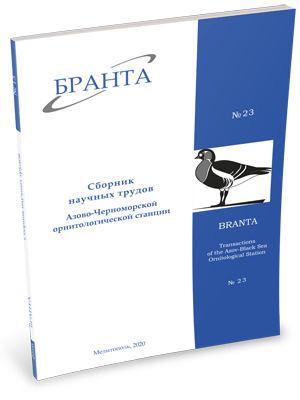
Transactions
of the Azov-Black Sea Ornithological Station



Characteristics of bird's visible migrations at the Dniester Delta in 1974-1976
I. I. Chernichko
The article deals with the results of observations of diurnal bird migrations and counts on a fixed route in the spring and autumn of 1974-1976, in the Dniester Delta. The total number of observation days was 82 (32 in spring and 50 in autumn, respectively). For this period, during observations and counts on the route, 135 bird species from 11 orders were registered, the total number of which exceeded 600 000 individuals. The study of migrations was carried out according to the E. Kumari method (1955). At the observation site, 80 species were counted, including 52 in spring and 60 in autumn. The Jaccard similarity coefficient (Jaccard index) was quite low between seasons and amounted to only 0.59. The frequency of occurrence of the majority of registered species was low. This may have been due to the area of the floodplains themselves, as well as to the weak extent of their anthropogenic transformation observed in the late 70s of the 20th century, which contributed to the bird migrations over the Delta in a wide front.
The density of the spring migration flow was maximum in March and averaged 1077.4 ind. (n=32) per a daylight, while the autumn migration flow was 1926.2 ind. (n=50). There were interannual differences in the density of migrations in March. In the spring of 1975, the flight density was 900.3 ind. (n=15), and in 1976 it was almost twice more and amounted to 2094.7 ind. (n=11). There were no interannual differences in the intensity of autumn migrations. The maximum migration density was 2585.2 ind. (n=23) in October. The majority of non-passerine bird species flew in the morning: in spring up to 43.8%, in autumn - 64.1%. The diurnal activity of Passeriformes varied by season: in spring, morning migrations prevailed (56.1%), and in autumn, with the same ratio in the evening (56.1%). The vast majority of flocks (87 - 90%) amounted from 1 to 50 individuals. At altitudes up to 50 m, 37.0% flew, 51-150 m – 24.9% and above 150 m – 38.1% of birds. For a number of species, it was proved that the height of their flights in the general for the season migration sector of directions was higher than in the reverse directions.127 bird species were registered on all routes, of which 106 were registered on a permanent (fixed) route. Maximum species diversity was observed in March – 85, in April − 65, in September − 60, in October − 61 and in November – 40 species. The dynamics of the species composition of birds on a fixed route can be used as an additional characteristic of day transit migrations.
References:
- Cherepanov, A. I. (1978). Results and objectives of the research on migratory birds and ecologically related arboviruses and other natural focal infections. In Transcontinental connections of migratory birds and their role in the spread of arboviruses. Novosibirsk: Nauka [in Russian].
- Kumari, E. V. (1955). Manual for the study of birds’ migration. Tartu [in Russian].
- Lvov, D. K., & Ilyichev, V. D. (1979). Bird migration and transfer of pathogenic agents. Moscow: Nauka [in Russian].
- Rusev, I. T. (2003). Delta of the Dniester: History of nature management, ecological basis for monitoring, protection and management of wetlands. Odessa: Astroprint [in Russian].
- Shchegolev, I. V. (1992). The visible migrations of birds in the North-Western part of the Black Sea region. In Seasonal migrations of birds on the territory of Ukraine. Kiev: Naukova Dumka [in Russian].
- Silaeva, O. L., Ilyichev, V. D., & Zolotarev, S. S. (2010). The main directions of avian ornithology. Bulletin of RUDN University: Ecology and life safety, (5), p. 10-14 [in Russian].
- Yacobi,V. E. (1977). Concretization of avian and ornithological research - the basis for implementation in practice. In Methods for studying bird migration. Moscow: AN SSSR [in Russian].